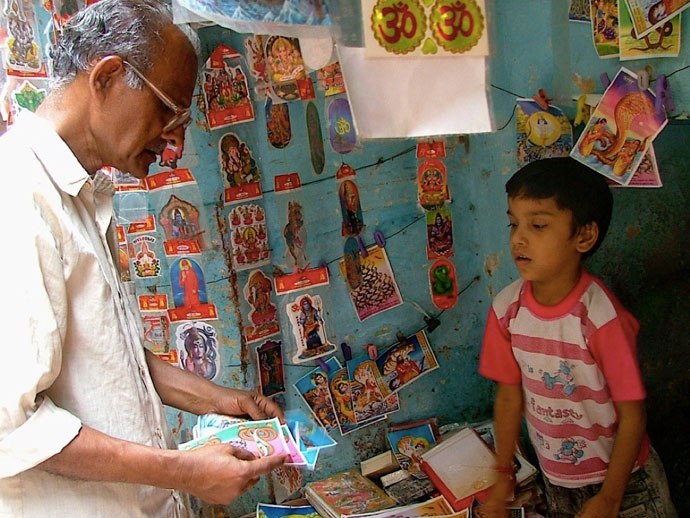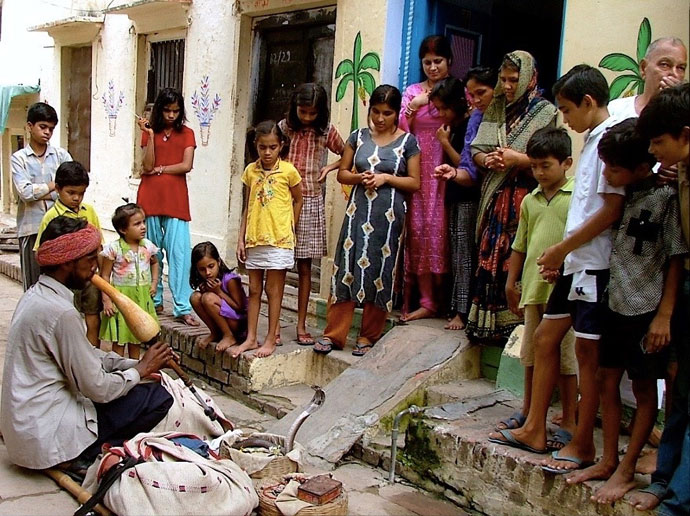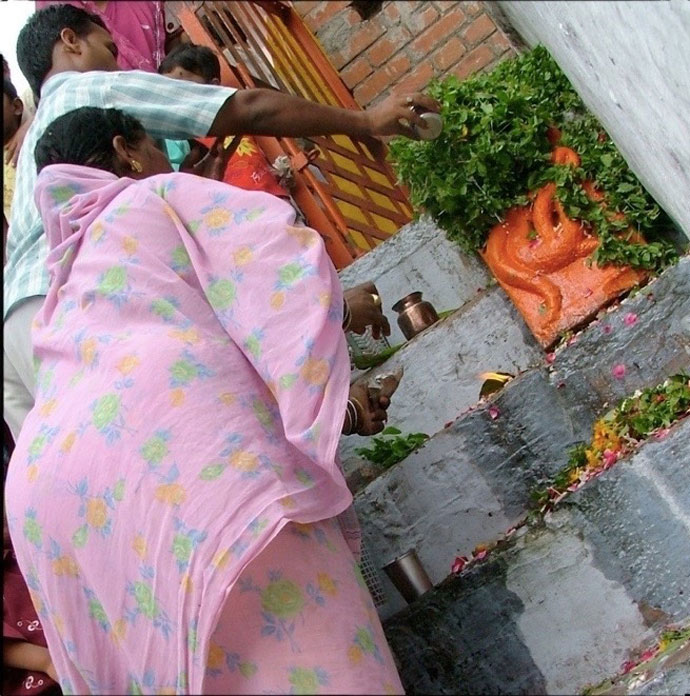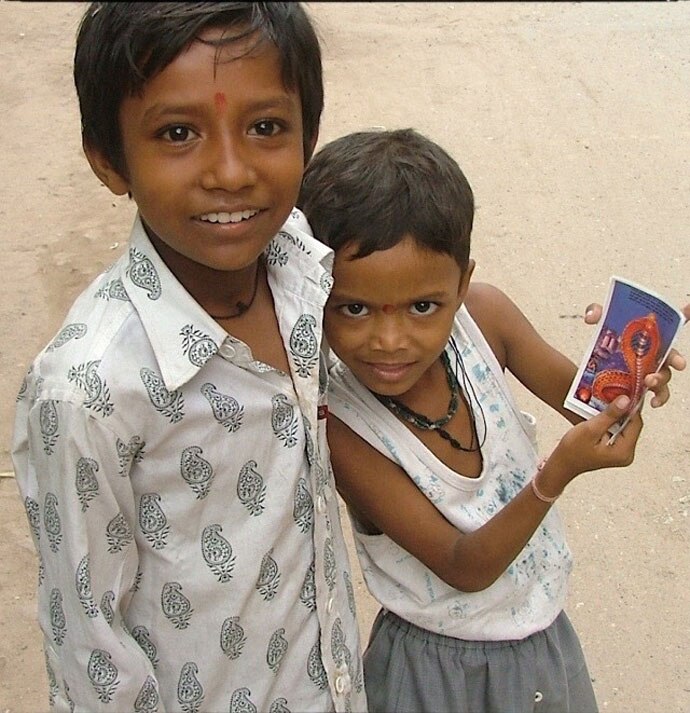In a city which boasts thousands of temples, mosques, and holy spaces such as Banaras, it is not unusual that smaller holy sites may fall by the wayside in the community's public memory of them. This is precisely what has happened to Banaras' Nāg Kuan, or serpent well. Located on the edge of Varanasi in one of the oldest neighborhoods in the city, this religiously important well and temple are hardly known by those outside its general neighborhood.
Situated worlds away from the hippie den and scholastic center of Assi Ghat, where I was living, I first read about this kuan in Diana Eck's seminal work on the city: Banaras: City of Light. Eck not only writes that this well was one of the deepest in the city, but she also states that believers consider it to be a tīrtha to the nāga loka (world). It is rumoured that throughout the year intrepid young men can often be found jumping into the well trying to reach the bejeweled and golden realm of the serpents.
Because of the importance has in various Purāṇas, the Jaitpura region of town is said to have one of the best celebrations on the day of Nāga Pañcam? Or so Eck's book assured me. Looking for the carnivalesque excitement I expected to surround this day, I soon realised that many local residents in my own small part of Banaras, were unaware of both the celebrations that happen in Jaitpura, or even the existence of this old neighbourhood. With the help of my dear friend, Rakesh Singh, proprietor of Assi Ghat's Harmony Bookstore, and some phone calls to local historians, I finally located the well and decided to visit it on the day before Nāga Pañcamīa.
The Nāg Kuan and its attached temple stands between the narrow lanes of the dilapidated neighbourhood of Jaitpura almost like a beacon - newly, repainted white and with the temple's paṇḍit adorning it with fresh betel leaves or nāgāvali (named for their serpent like form). While the paṇḍit of the temple was far too busy to talk to me on the day before the celebrations, his hands wrapped in the coils of the nāgāvali leaves that he was hanging, other residents of the village were more than happy to regale me with the myths and narratives of the well.
It was then that I came to find out that the community surrounding the old kuan was primarily Muslim. Walking in and around the interior of the temple and kuan, it became clear to me that they were the de facto tour guides of the area and were ostensibly responsible for its yearlong care and upkeep. Taking me past the gymnasium housed within the temple, and helping me down the dangerously steep stairs of the kuan, they pointed out the most important nāg stones to which people give darśan. They also informed me that this kuan is considered to be the home of Patañjali (author of the Yoga Sutras and an incarnation of Śeṣa nāga). While this religious site may have been unknown to those in other parts of Varanasi, in Jaitpura, the story of the nāg loka and all that it could potentially offer was prominently enveloped in the minds of all its residents. Especially on the day before the festival.
Nāga Pañcamī is celebrated on the fifth day of the Hindu month of Śravaṇa, which according to the lunar calendar falls within the months of either July or August: India's rainy season. Taking an auto through the narrow lanes of Jaitpura on the day of Nāga Pañcamī, a sense of thrill and excitement permeated the air. Vendors had mysteriously popped up overnight selling every type of nāg merchandise one could imagine and children gleefully ran rampant through the lanes around the temple with their toys and noise makers in hand.
The Nāga Pañcamī festival is particularly important for those who affiliate themselves with the saperā or snake charmer community. Although there has been a ban on snake charming since the 1972 Indian Wildlife (Protection) Act, this ban does not stop the community from continuing their profession when it is lucrative to do so. So the streets of Banaras were filled with different saperā (some as young as ten) who gave viewings of their cobras for a negotiated price. Although a sense of wonder and the threat of danger seemed to occupy all those who viewed the live cobras, this was not the main reason that many stood face to face with the defanged serpents. The Dharmaśāstra declares the propitiation of these cobras and their imagery is particularly auspicious on Nāga Pañcamī. It states that if gifts are given and rituals are completed properly, those who partake in this day's activities will not only remain safe from snake bite; but also obtain worldly wealth and happiness.
As still as the neighbourhood had been the day before, On Nāga Pañcamī the temple itself was inundated with multitudes of people trying to press their way to the head of the line. The paṇḍit who had only yesterday been quietly hanging nāgāvali, was busy giving blessings to those who took darśan from the main Nāg stones. Practitioners pushed their way into the next room, where bright and beautiful small posters of nāgs were worshipped under a large peepal tree. The gym equipment that had been present the day before, was useless today and had been set to the side of the room away from the crowds.
Elderly women and newly married couples walked up and down the frighteningly steep steps to the kuan. They threw flowers into the well's water and gave offerings of milk and fire to the nāgs. After their prayers are said, they carefully move to another spot to continue giving offerings to the nāg stones that appear on the sides of the temple.
Throughout all of this, Nāga Pañcamī, in Jaitpura does seem to be, as I was told, "A children's festival". While the adults shift from spot to spot giving alms to the nāgs, it is the children who seem to have the most fun during this event. Festival rides are brought in the neighbourhood and placed outside the temple, sweets and savoury foods are sold, and children trade and treasure their nag posters as if they are baseball cards. The day continues like this until the sun starts setting and people return to their homes, leaving only fallen betel leaves and empty dīyās as trash on the ground.















